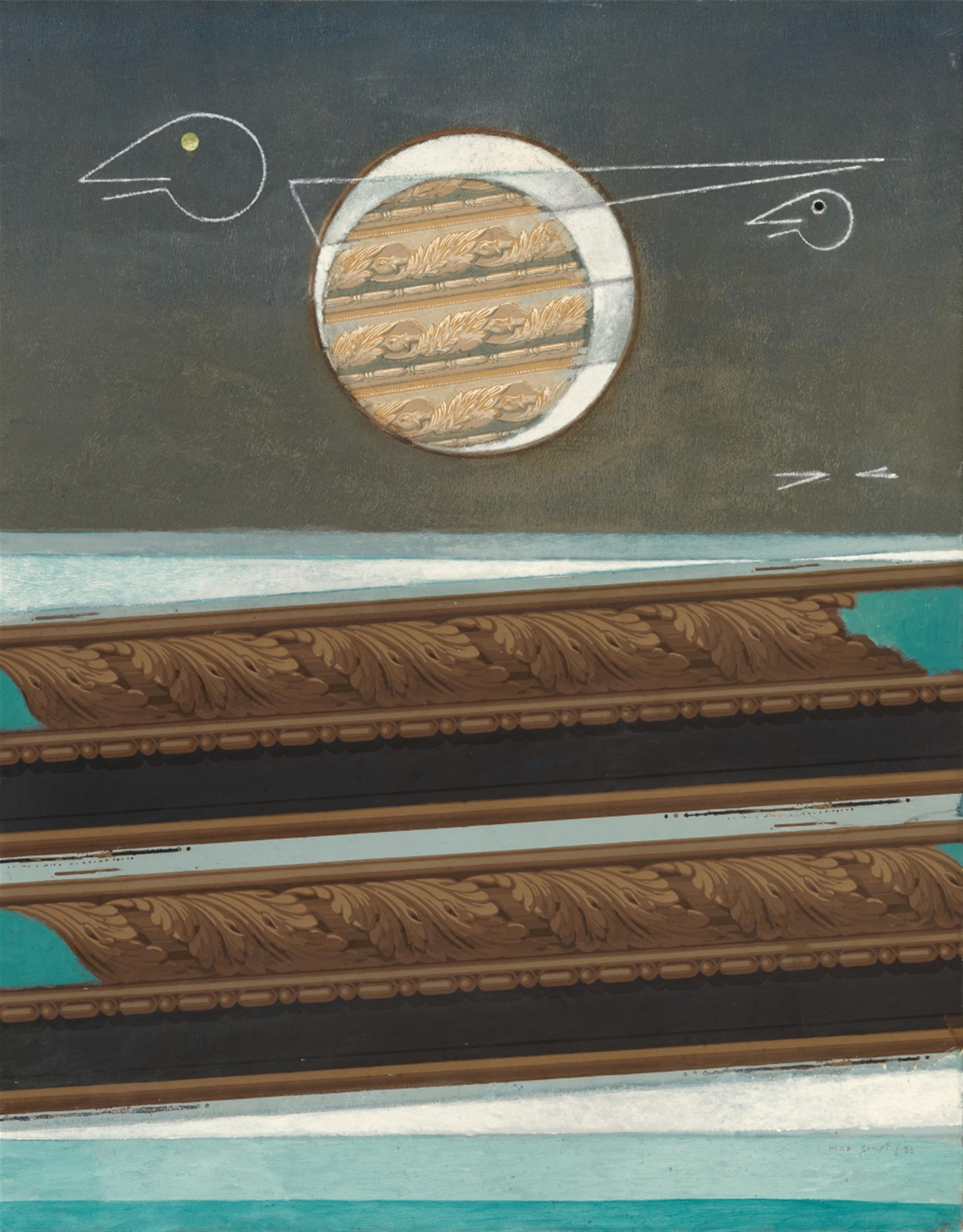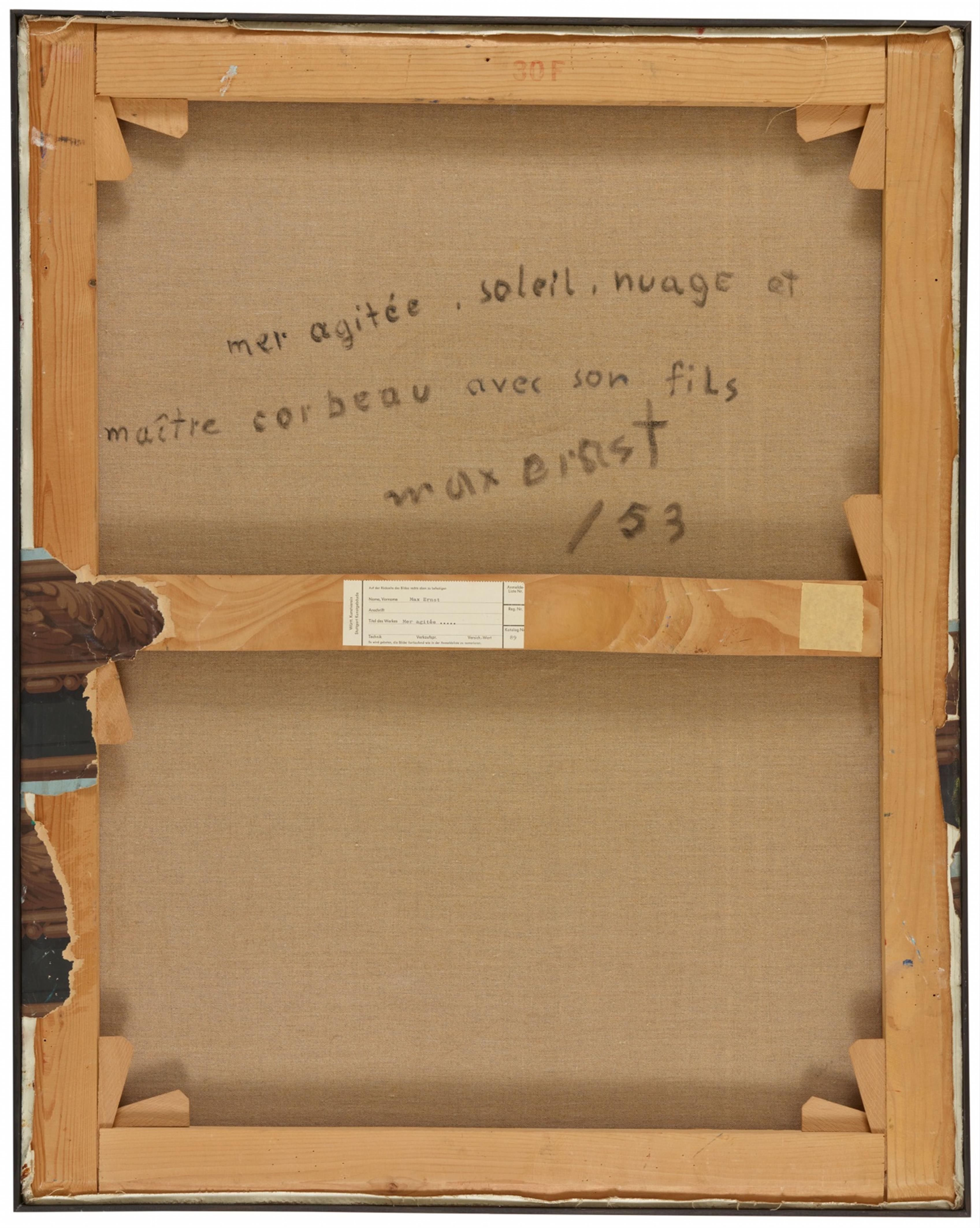Max Ernst
Mer agitée, soleil, nuage et maître Corbeau avec son fils
1953
Collage and oil on canvas 92 x 73 cm Framed. Signed and dated 'max ernst/53' in grey lower right as well as verso signed, dated, and titled 'mer agitée, soleil, nuage et maître corbeau avec son fils max ernst /53'. - In fine condition.
“1906. The Vogelobre Hornebom. A friend by the name of Hornebom, a clever and loyal bird with bright spots dies in the night; a child, the sixth in order, enters life in the same night, chaos in the brain of the otherwise so healthy boy. A kind of interpretive mania, as if the innocence just born, sister Loni, had appropriated the vital fluids of the dear bird in her lust for life. This crisis is soon withstood. However, a voluntarily irrational ideational amalgamation of people with birds and other creatures remains in the boy's fantasy, and this is reflected once more in the emblems of his art,” writes Max Ernst in his biographical notes (cited in: Exh. cat. Max Ernst, Wallraf-Richartz-Museum Cologne/Kunsthaus Zurich 1962/1963, p. 23).
This museum-quality painting created by Max Ernst in 1953 is formally consistent with his sea-star pictures. However, in its surreal qualities, it goes far beyond their modes of representation.
In 1931 the artist had already recurred back to the medium of collage in his landscapes by arranging (sometimes painted) fragments of old wallpaper and providing his pictures with a plausible or fantastic title. This is also the case in our picture: in the oscillation between immobility and movement, viewers can recognise surging waves in the two strips of wallpaper. A cool freshness is suggested by the glittering sea, with its linearly organic acanthus ornamentation consisting of somewhat obliquely collaged pieces of wallpaper and a clear triad of blue, light blue and white. The sun, which dominates the sky and is not entirely painted in at one point, is covered by a smaller, three-dimensional-looking “cloud”. For this element of the composition, Max Ernst has used a collaged circle cut from a patterned wallpaper that permits associations with a cloud. According to the title, it is “Master Crow with his son” who float in the sky. The heads of the birds were created with the help of drawing stencils. In Ernst's vision, these already had the shape of a bird's head. He positioned them in the picture, traced around them and completed two birds' heads with a white and a black dot. Also a master of his picture's titles, the artist indirectly alludes to Jean de La Fontaine's fable “Le Corbeau et le renard” here, thus expanding the complex materiality of collage through a poetic dimension.
Nature, cosmos, stars, birds, forests and the sea are central themes that also remained present in Max Ernst's work after he returned to France. Initial depictions of the landscape, horizon and sun can be found in the mid-1920s, where they are identifiable leitmotifs in the form of romantic and easily recognised pictorial motifs between more enigmatic compositions.
Ernst's central phase of work in France began after his return from the US. In 1953 he created art historically important works that are remarkable and diverse in terms of technique, including “Vater Rhein” (Spies/Metken 3007), “Heuschreckenlied an den Mond” (Spies/Metken 3029) and the present work (Spies/Metken 3025). From 1953, after the artist had been able to purchase a bundle of old wallpapers from a defunct department store, he once again dedicated his attention to the sea-star collages, continuously elaborating upon the technique of collage and oil painting on canvas that he had initiated in the 1930s. With his early collage novels and the collage pictures mentioned here, Ernst created pioneering works that were seminal for the art of the 20th century, and they continued to influence central positions in postwar art, such as pop art.
“Mer agitée, soleil, nuage et maître Corbeau avec son fils” was created immediately after Max Ernst returned to France. Recurring back to the 1930s, it embodies the defining aspect of linking together his artistic leitmotifs on many different levels.
This picture's laconic allusion to Jean de La Fontaine's fable “Le Corbeau et le renard”, through which the artist surrealistically and ironically deals with the theme of fathers and sons, is characteristic and typical. The appearance of Ernst's emblematic alter ego of the anthropomorphic avian creature - “Vogelobrer Hornebom”, “Schnabelmax” and “Loplop” - allows us to recognise a complex, self-reflexive aspect and is not without humour. Within this context, the picture points not just to the transcendental dimensions of nature and the cosmos, but also to that enigmatic amalgam of intellect, mythology and personal biography which makes Max Ernst one of the most multifaceted fine artists who shaped the 20th century.
The fact that, throughout his life, the artist retained this work within the immediate surroundings in which he lived speaks for itself. Afterwards it was donated by his widow Dorothea Tanning to a family member.
Catalogue Raisonné
Spies/Metken 3025
Provenance
Artist's estate, in family possession since
Literature
Werner Spies (ed.), Max Ernst, Leben und Werk. Dokumentarband zu "Max Ernst. Oeuvre-Katalog", Cologne 2005, with. colour illus. p. 255
Exhibitions
Stockholm 1969 (Moderna Museet), Max Ernst, cat. no. 79, with illus. p. 61; Amsterdam 1969/70 (Stedelijk Museum), Max Ernst, cat. no. 75; Stuttgart 1970 (Württembergischer Kunstverein), Max Ernst, cat. no. 89, with illus. p. 142 (exhibition label verso); Max Ernst Museum, Brühl (permanent loan from the Ernst family 2007-2021)




